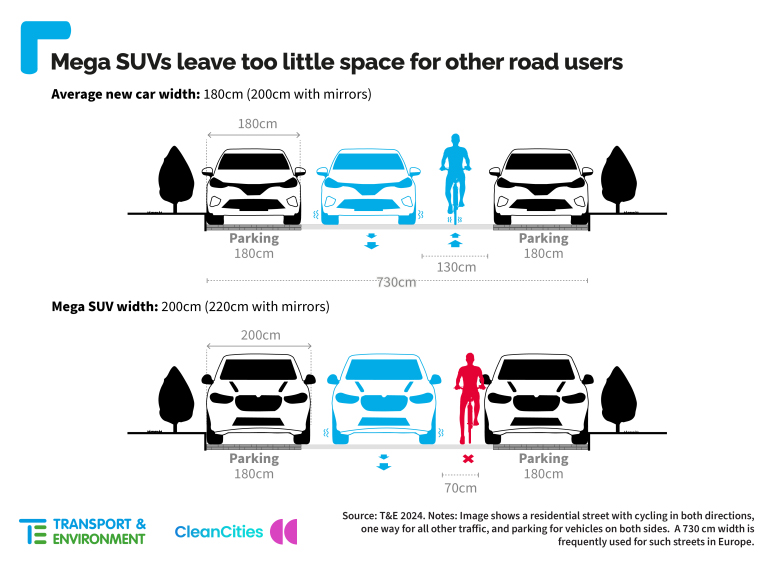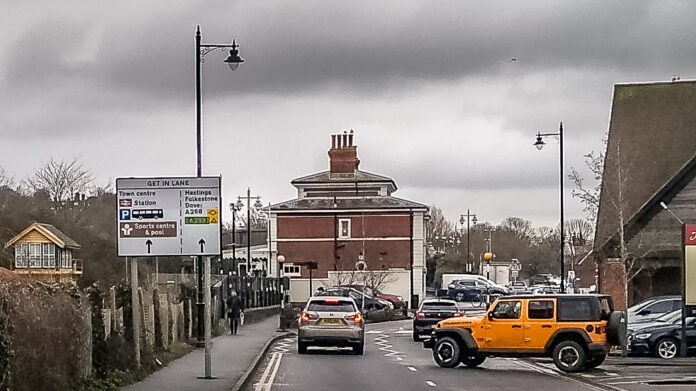Thank you, Guy Harris, Peter Munro and Jacqueline Patton, for writing the excellent letter to ESCC I look forward to seeing the response.
Locally and nationally the proliferation of potholes has been blamed on the recent heavy rain. However, there are two factors that cause potholes: weather and traffic. Government policy has totally failed to reduce not just the numbers, but also the weight of road vehicles The number of vans on the roads has increased to 4.5m, up from 3.3m in 2012. The number of cars has increased from 27.2m in 2000 to 32.7m in 2020.
But the size and weight of cars has increased dramatically too. In 2009, SUVs accounted for just 6.6% of cars sold in the UK, in 2023 that had increased to 60%. If the trend continues then in 2027 SUV registrations could make up 75% of new registrations. Not only that, but year on year since 2001, the average SUV gets half a centimetre wider (see Transport and Environment article). And let us not forget the effect on cyclists – for each increase in width of car, that is a decrease in road width for the cyclist.

Big cars are more likely than small cars to kill people in crashes because they weigh more and have tall front ends that trap victims beneath them instead of knocking them to the side. They also pump more toxic gas into the air and eat up more space on roads and pavements. The UK is a ‘tax haven’ for polluting SUVs. Britain’s first-year vehicle excise duty (VED) charge does nothing to incentivise the purchase of less damaging cars.
And note, the gradual switch to electric cars does nothing to mitigate the damage to roads, in fact these cars are generally heavier due to the battery packs. Likewise, the amount of microplastics shed by the tyres is much the same. The solution then is not just reducing the amount of traffic, but the weight of the vehicles too.
And not to forget, domestic transport is by far the largest emitter of greenhouse gases of all sectors, at 26%.
So when we are talking about potholes, we also need to talk about the reckless Conservative policies that encourage climate change and endorse the irresponsibility of the motor vehicle industry. There is a direct causal link.
Image Credits: Geoffrey Austen , Transport and Environment .




Dominic is wrong to limit the causes of potholes to weather and traffic. A major cause, perhaps even bigger than those, is a poor maintenance strategy over several years from both East Sussex Highways and National Highways. As an example in 2022 the A259 New Winchelsea/Winchelsea Road was resurfaced. The work was extensive and well executed by the contractors and we have now the best and quietest surface probably in the last 40 years. However National Highways excluded from the project any work on the surface drainage systems, despite on line reporting in Oct 22 and assurances that remedial work would be carried out, the majority of the drainage remains blocked and ineffective leading to surface water causing deterioration to the new surface, adjoining pavements and properties. Come the summer there will once again be grass growing from the drain covers again. Reactive rather than proactive maintenance policies over the last few decades have to change, some locally authorities are at last beginning to realise the false economy of these methods and are switching back to “find it and fix it” approaches – time for others to do the same
A major problem with potholes is the ESCC criteria used to determine when and how they are filled. A single deep pot hole may be repaired but the shallower ones around it (which will soon become deep) are left. Consequently, rather than one trip to repair a section of road there are many – overall more costly – visits to fix individual issues. Add in usually opting for a cheaper ‘cold fill’, essentially just tamping in asphalt, rather than a ‘hot fill’ – poured in, rolled and sealed at the edges – and we have the current parlous state of local roads (and if you think Rye is bad visit Hastings and St Leonards).
Regarding SUVs – they tend to be purchased on a false premise. All wheel drive is only useful if you know how and when to use it – most owners don’t and still get stuck in mud and slow. Also, they have a high centre of gravity and are much more prone to roll over than other car designs. Plus they’re too big to fit many parking spaces…
I find the headline ‘The scourge of SUVs on our roads’ somewhat discriminatory. Our hybrid RAV 4 is often to be seen on Saturdays heading to and from Rye Craft Fair loaded to the gunwales with local products which will be offered for sale.
Yes it is bulkier than a car, though smaller than a Ford Mondeo. Yes it is hybrid and carries an small extra battery for this facility, but is economical at 52 mpg on petrol, so is environmentally friendly. What is there not to like?
In the past estate cars manufactured by Ford, Mercedes and Volvo graced our highways and still do, they were the favouite means of transport for many familes. All are bigger than modern SUVs.
Personally I do not like sports cars and have never owned one, but I would not encourage or support a campaign against them, that would be discriminatory.
Articles such as the one above also encourage those ‘urban warriors’ who have taken it upon themselves to damage parked SUVs in the dead of night, without knowing or caring what use the vehicle is put to.
We all have different lifestyle choices, I say we should keep it that way without discrimination.
Well said.
Facts: Not all cars that resemble SUVs are a) over-sized, b) fuel guzzlers or c) 4-wheel drive. ‘Sport Utility Vehicle’ is just an American manufacturer marketing descrpition.
In the UK, even the traditional Land Rover, as used by farmers for decades, has a small footprint. It is only when they got glamourized for the high-end market that they started getting bigger. The point is not to tar the vehicle style with the same brush. ‘SUV’ is just a style term, regardless of size and off-road capabilities.
Facy: some so-called SUVs have a smaller footprint than a large saloon car. Some basic petrol models can achieve 60 miles per gallon. What exactly is wrong with that?
Fact: SUV drivers sit slightly higher than they would in an average car, enjoying better visibility, not to mention more room for possible work use, travelling with kids, prams, shopping, etc. – all very good reasons this vehicle style is so popular.
As for the folls busy deflating tyres, if this is meant to be some sort of life-affirming action, how about they stop and think how they may in fact be putting road users and pedestrians in mortal danger when an unsuspected deflated tyre/s causes a serious accident.
When the ‘ideal world’ is achieved, every village and town will be served by truly affordable and reliable trains. Everyone will be on bikes using comprehensive dedicated bike routes. Workers who have equipment to haul will have fantastic cargo bikes. There will be excellent secure bike parking everywhere and rampant bike theft will stop. The elderly and physically challenged will have all sorts of nifty personal non-car transport and endless help carrying things from A to B. And, of course, there will be no cold wind, sudden rain, etc. to make outdoor bike travel miserable. Hang on…this sounds like Heaven! Which is where we will all be (well, maybe not all of us exactly) before any of this ever happens.
Sadly, many of our older, narrow lanes and roads weren’t built with large vehicles in mind and there’s nothing that can be done apart from widening them, which would involve the loss of pavements and pedestrian safety. SatNav’s are also the culprit of many a large vehicle being led down a road that’s far too tight (this often happens on All Saints Street – or All Sorts Street, as some of us call it! in Hastings Old Town). One can see the fear on the driver’s face as they try and manoeuvre their SUV past parked cars.
Not only has there been a poor maintenance strategy nationwide, but I am far from convinced that the current desperate efforts of highway authorities are actually working. Looking around, I suspect the roads are deteriorating at an accelerating rate, which means that repair efforts need to sprint, not just run.
Simon makes many excellent points from an engineering point of view, especially around preventative maintenance. If Dominic wishes to blame a single vehicular cause, I am not sure a generic attack on SUV’s in their entirety is a logical target. SUV’s come in many sizes, from too big for our roads, to deceptively small. Unladen weight is clearly a problem when it comes to breaking up roads, hence why HGV lorries are charged accordingly much more than cars. In which case the introduction of electric cars which are significantly heavier than ICE equivalents, are probably to blame. Maybe a significant increase in road tax for electric cars may be the way forward?
I suspect an increasing number of drivers are buying SUVs because (in most cases) the suspensions will be more ‘pot hole resistant’ and they feel safer. Therefore, improving the condition of the highways network should reduce the demand for SUVs?
Some folk need 4wd/awd for work purposes, of course. I use my 4wd car to transport timber around our wood – but it doubles up as a general runabout. ‘Working’ SUVs are generally easier to spot because like mine, they are embellished with mud – and not just on the exterior! (Admittedly I wash the lights only once a year for MOT purposes!).
The government don’t want the potholes repaired. It saves the councils money and makes a fortune for the recovery and repair garages. It makes people drive more carefully by avoiding the potholes and may drive people on to public transport, therefore reducing pollution.